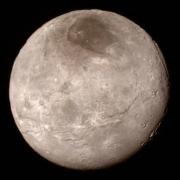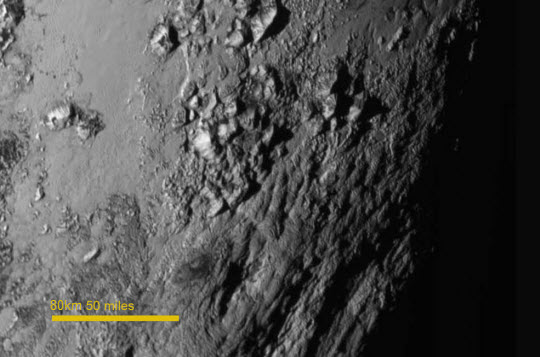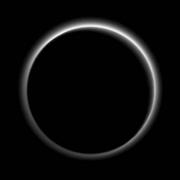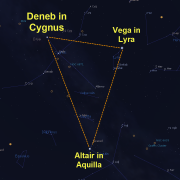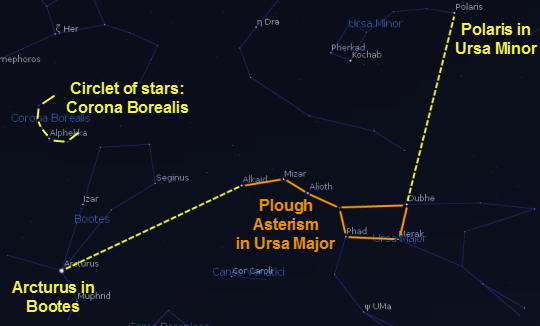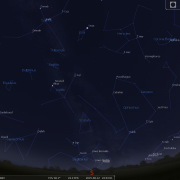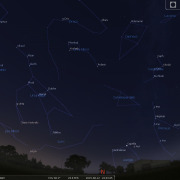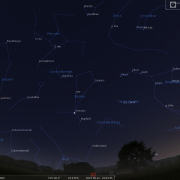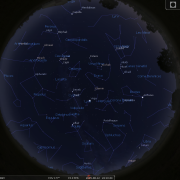Welcome to the WDAS monthly newsletter for August 2015: a digest of the month's latest contributions to our website. Below you'll find Society News, Sky Notes and In-Focus articles printed in full. There's also future events, and trailers for other articles which appear in full on the website - just a click away!
On the website you'll also be able to comment on articles, and if you'd like to play an editorial role in creating new content, just let us know!
Quick Summary for August:
- At the bottom of the newsletter - and of course on the website - you'll find lots of scheduled star party events. All subject to weather, of course; but if the right evening presents itself, especially as nights start to draw in again, we will endeavour to host an unscheduled event or two as well.
- As we head towards the busy Regatta, Folk week and Bank holiday period, assistance with setting up, manning and generally helping out would be greatly appreciated.
- Don't forget the Perseids Meteor Party on Archery Green on Wednesday August 12th!
Society News
Members of the society travelled over to Kettleness on July 18th to host a star party for a visiting party of cub scouts; the Osbaldwick and Murton Cub Scouts, requested by their leader Julie Lund.
All were looking forward at the prospect of being able to view Saturn in the summer night especially as skies were forecast to be clear. Unfortunately almost total cloud cover greeted our arrival, but we still deployed the scopes just in case breaks appeared; they didn’t.
The first part of the backup plan saw a presentation in the activities room using the laptop and projector, and a quick trip through the solar system and beyond. Then, outdoors again to give the scaled solar system demonstration, which worked very well at this venue; the old railway station, the long strip of grass of the rail bed and platform being ideally suited to distances involved.
Certainly the glow lights used for planets showed up nicely along the edge of the platform and there were plenty of eager ‘planet bearers’. It was such a pity that the real planets remained hidden and the optimistically deployed scopes idle. All the same i think the cubs enjoyed themselves, especially those doing their astronomy badge. Thanks to John, Keith, Lee and Andi for support, equipment and transportation.
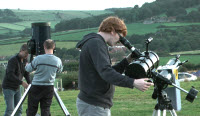
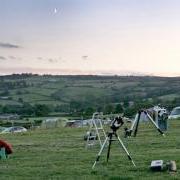 Certainly one of our observing highlights on the WDAS calendar, we are hoping to host two events at Hook’s House this year; one on Aug 22nd and another on Sept 5th.
Certainly one of our observing highlights on the WDAS calendar, we are hoping to host two events at Hook’s House this year; one on Aug 22nd and another on Sept 5th.
The Aug 22nd event will coincide with a quater phase moon, whilst the 5th will be a dark sky event. Should the first two dates fall victim to the weather, we shall try again on Sept 12th.
All events have a members set up time for 8pm. Hook’s House is an excellent dark site location situated on the B1447 overlooking Robin Hood’s Bay. If the weather is fine the campsite WILL be busy, and if skies are clear enough we should have a cracking evening, as always.
In-Focus
Wow, what a success story New Horizons has been so far, rewriting the text books on Pluto, and providing a wealth of insightful data on the likely makeup of other Kuiper belt objects, and the vast majority of data is still to be beamed back.

High-Res Pluto, unveiled to
the Public as New Horizons
made its closest pass of Pluto.
(Click for full-sized image)
It could have been a very different story, as barely a week before New Horizons was scheduled to encounter Pluto, the probe disappeared from NASA’s scanners for around an hour, before coming back online in safe mode. It turns out a flaw in the software caused the system to crash.
High-Res Charon (Click for
full-sized image, which shows
even higher-res detail from
part of the moon.
The probe then had to be targeted through an extremely small area, skimming above the small world just over 11km (7000 miles) up and taking less than 3 minutes to do so. It turns out that at 2,370km (1,473 miles) in diameter, Pluto is slightly larger than previously believed. This makes it indisputedly the largest dwarf planet in the solar system... for now.
In those three minutes the probe would collect as much data as possible, before transmitting back just a few images. This takes time, although New Horizons has a large dish antenna, the probe is so far away the data rate is only 1-2 Kbps. It takes 30-60 minutes to send even one high-resolution image back to Earth.
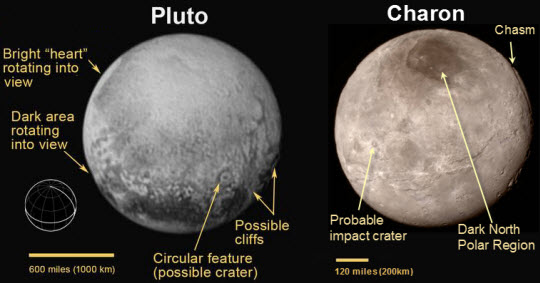
Some details of note on Pluto and Charon which have surprised project scientists:
Almost no impact craters suggest an evolving surface, mountains, chasms, Nitrogen snow
After a nerve jangling several hour wait, the probe called home and a few images were downloaded. These were a revelation revealing fascinating details, Ice Mountains, ice flows, not many craters; implying that the surface is young and a prominent heart-shaped feature, known - so far unofficially - as Tombaugh Regio, after Clyde Tombaugh, discoverer of Pluto. A close up image of the region near the base of this feature shows a mountain range with peaks jutting as high as 3,500 metres (11,000 feet) above the surface of the icy body, similar in height to the Rocky Mountains on Earth and estimated to be no older than 100 million years.
The surface colouring of Pluto suggests it is a patchwork of different concentrations of frozen methane and nitrogen. These probably sublime into the atmosphere when the planet is closer to the sun and drift back to the ground as snowfall during colder periods.
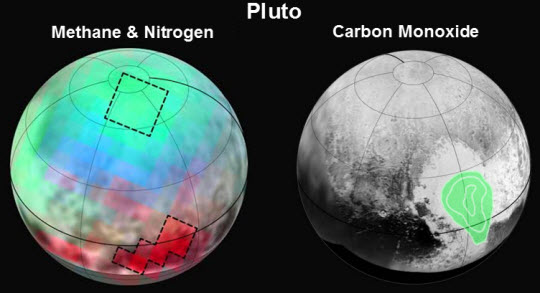
Left: Solid Methane and Nitrogen in varied abundances, and diluted with Nitrogen
on Pluto's North Pole. Right: Carbon Monoxide as rock in Pluto's "Heart".
Speeding away from Pluto just seven hours after its July 14 closest approach, the New Horizons spacecraft looked back and captured a spectacular image of Pluto’s thin nitrogen atmosphere, extending far out into space, and backlit by the sun, something that scientists hoped to see. Apart from its major moon Charon, which resembles some of the moons of Uranus, New Horizons also observed the smaller members of the Pluto system; Nix, Hydra, Styx and Kerberos. There will be more images of these in the coming months.
The Pluto flyby may well be over, but the mission is set to continue. For a start, the data stored on its onboard recorders will require 16 months to send back, plenty for scientists to scrutinise for years to come, and hopefully in 2018 or 2019 New Horizons will sweep by another kuiper belt object. I have a feeling many exciting discoveries await!
Image Credits: NASA
Sky Notes
In this month's Sky Notes:
Planetary Skylights

 Both Venus and Jupiter are lost in bright twilight by mid August, leaving Saturn as the centre of attention in the evening sky. Venus will return to the dawn sky at the end of the month, visible low in the ENE around 05:00h.
Both Venus and Jupiter are lost in bright twilight by mid August, leaving Saturn as the centre of attention in the evening sky. Venus will return to the dawn sky at the end of the month, visible low in the ENE around 05:00h.
 Saturn remains fairly conspicuous across in the SW as twilight deepens, residing in the constellation of Libra, through which it is in retrograde motion. You will require a telescope to resolve the glorious ring system, which is orientated at its widest, but pick a calm, slightly hazy night to minimise possible bad seeing through air turbulence. Look out for Titan, Saturn’s largest moon, visible as a speck of light nearby.
Saturn remains fairly conspicuous across in the SW as twilight deepens, residing in the constellation of Libra, through which it is in retrograde motion. You will require a telescope to resolve the glorious ring system, which is orientated at its widest, but pick a calm, slightly hazy night to minimise possible bad seeing through air turbulence. Look out for Titan, Saturn’s largest moon, visible as a speck of light nearby.
 Our Moon lies in the vicinity of Saturn on 22nd August.
Our Moon lies in the vicinity of Saturn on 22nd August.

 The outer gas worlds of Uranus and Neptune are visible in the early morning hours in Pisces and Aquarius respectively.
The outer gas worlds of Uranus and Neptune are visible in the early morning hours in Pisces and Aquarius respectively.
Meteor Activity
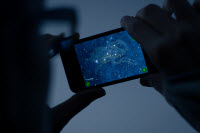
Ready to capture Perseids
When amateur astronomers refer to the 'glorious 12th' they are not contemplating shooting grouse, pheasant or any other game bird. They are however anticipating shooting stars! The 'shooting stars' in question are the Perseids, one of the more prolific meteor showers and most widely observed given that it occurs during summer, when nights are less cold.
In some regions of the world the Perseids are also known as "The Tears of St. Lawrence", because the feast day of that saint falls on Aug 10th, just two days before the meteor peak. Laurentius, a Christian deacon, was said to have been martyred in 258 AD after being roasted alive by the Romans on an iron outdoor stove. It was in the midst of this torture that Laurentius cried out: "I am already roasted on one side and if thou wouldst have me well cooked it is time to turn me on the other."
These particular 'tears', like the majority of meteor showers, are a classic example of a cometary meteor stream, debris deposited over many thousands of years by periodic comets. Perseids are associated with comet Swift Tuttle which was discovered in 1862 and takes approximately 130 years to circle the Sun. With each pass the comet leaves behind fresh material, of which Earth encounters various strands every August, giving rise to the Perseids,
The names of all meteor showers are linked to the constellation, or particular region of sky from which the meteors seem to emanate from, a position known as the radiant of the shower. The Perseid radiant lies to the NW of Perseus and varies slightly in position over the time scale the shower is active. Perseid meteoroid debris is typically the size of instant coffee granules with the occasional pea or marble sized fragment. These penetrate the upper atmosphere some 60 miles up at speeds of 37-43 miles/sec. As they do so, the atoms of the particle interact with the atoms in the atmosphere and through a process known as ablation become ionised, releasing a packet of light. It is this brief luminous flash we call a meteor. Particularly bright examples often leave behind persistent ionisation trains in their wake, the classic shooting star.
Starting in late July, Perseid activity is highest from Aug 8th-15th, normally peaking in the early morning hours of Aug 12th. The ZHR (zenith hourly rate) is often quoted to be around 60-80 per hour. This assumes the radiant is overhead, there is no light pollution and you have all round vision. Some fish and birds would make great meteor observers, humans unfortunately rarely do.
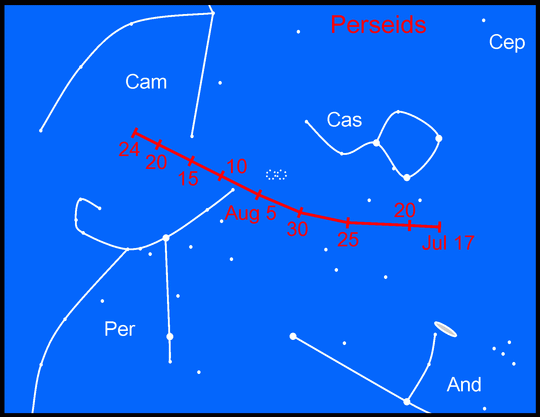
Also the Perseid radiant is low in the north-east during the early evening, rising higher in the sky by dawn, so observed rates are always substantially lower. Natural light pollution will be absent with the moon out of the way. Perseid maximum in 2015 is actually predicted for Aug 13d07h UT and so the best observed rates are likely to be seen late in the night of Aug 12-13. However, good rates are also likely during the nights of Aug 10-11, 11-12 and 13-14. Expect to witness up to 30-40 per hour in the early morning hours, with 10-20 visible during the late evening hours. My own record is 128 in 2 ½ (12-2:30am) back in 1979.
Observing meteors can be a frustrating affair, just like the preverbal bus you can seemingly wait ages for one and then several appear within a few seconds. Have patience, warm clothing, a warm drink and a snack. Some people watch from a deck chair or lie -low, it all helps to stave off cold and tiredness during the 'barren interludes'. The majority of meteors will be visible post midnight, when our part of the world becomes the 'leading' hemisphere, and faces directly into the path of oncoming particles. It is customary to look halfway between the radiant and the zenith (the imaginary point directly overhead) and 40-50 degrees either side of the radiant.
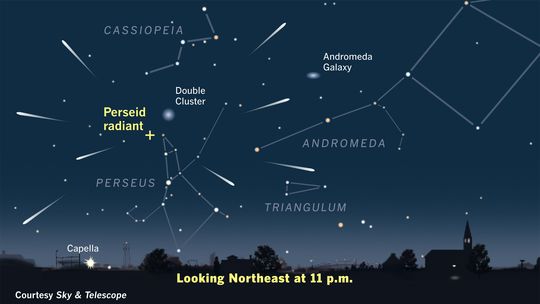
Over the years I have found that the 'Summer Triangle' visible high to the south, the Plough; high in the NW, and the Square of Pegasus, rising to the east, are good regions to keep tabs on. Shower members appearing close to the radiant have foreshortened tracks; those appearing farther away are often brighter, have longer tracks and move faster across the sky.
The Perseids offer up an excellent opportunity to image a shooting star. You will need to steady your camera, so a tripod is very useful. For digital cameras with a night sky mode, keep lens a widest (low power) and try 30 second exposures. Cameras’ with B settings try longer images, but keep ISO rating to a 100, otherwise the image will fog with extraneous light spill. W.D.A.S will be holding a Perseid star party on the West Cliff on Aug 12th but not from our usual location near Cpt Cook's statue. Instead you will find us on the Archery Green - next to the boating lake (less light polluted) from 9pm. We'll provide a scope or two to enjoy some of the summer sky wonders whilst we wait, bring a folding chair a warm drink and nature may provide the fireworks!
August Nights - ‘The Dark Nights’ Return
Late August sees the resumption of astronomical twilight, the deepest level of ‘darkness’ experienced and so the majority of stars are visible shortly after 10pm, making it somewhat easier to identify constellations. The most familiar of these; the saucepan outline of the ‘Plough’, which is part of Ursa Major – the Great Bear, can be located high in the NW. The curved ‘starry’ handle points down in the direction of Arcturus, brightest of our summer luminaries, situated at the foot of Bootes – the herdsman.
Note the delicate starry circlet of Corona Borealis situated to the upper left of Arcturus. By utilizing the ‘pointer stars’ in the bowl of the Plough, one can pinpoint isolated Polaris, the pole star in Ursa Minor. The star often wrongly mistaken for the ‘North star’ at this time of year, Capella, scintillates low to the north in the circumpolar constellation of Auriga.
Much of the SW aspect of the sky is occupied by two large and sprawling constellations. The figure of Hercules, best identified by the ‘keystone’ asterism, stands upper left of Corona, whilst the vast, rather faint outline of Ophuichus – the Serpent Bearer extends down from Hercules towards the WSW horizon. Arcing just above the southern horizon, the stellar asterism known as the ‘Teapot’; the most distinctive part of Sagittarius may be traced if sky transparency is good. It is a pity that from UK latitudes the Archer is too far south to be fully appreciated, especially as this region contains many fine deep sky objects.
Much of the aquatically themed SE aspect is occupied by zodiac constellations, including Capricornus, the Sea Goat, Aquarius - the Water Bearer and Pisces the Fish. Dark skies are required to pick out the outlines of these less conspicuous constellations.
High overhead to the south and east reside three bright stars. Steely blue Vega in the small geometric pattern of Lyra is the most conspicuous, whilst to the east Deneb sits at the tail of Cygnus the swan. Pearly white Altair in Aquila the Eagle shines midway up in the South. These three stars are also known as the ‘summer triangle’ a term first used in the fifties by Sir Patrick Moore which has subsequently passed into popular usage. On the edge of the ‘triangle’ note the small arrow shape of Sagitta- the Arrow, together with the close-knit pattern of Delphinus - the Dolphin situated to its left. Sagitta certainly gives the impression of an arrow and with a little imagination; Delphinus does resemble the outline of a dolphin leaping out of water. Bizarrely Delphinus is sometimes known as ‘Jobs coffin’
Over in the NE the great hero Perseus begins to climb away from the horizon. Above, the familiar “W” pattern of Queen Cassiopeia holds court. Her daughter, Princess Andromeda, located to the lower right is marked by a chain of stars extending away from the winged horse Pegasus which occupies the mid regions of the E sky. Pegasus is best identified by ‘the great square’, an arrangement of four stars which enclose a sparsely populated patch of sky. As the constellations associated with summer wing their way westwards, the appearance of the winged horse heralds the onset of a new season in the sky. Autumn approaches.
|
Looking South
Mid August - 22:00h |
Looking North |
|
Looking East
Mid August - 22:15h |
Looking West
Mid August - 22:00h |
|
|
|
|
Overview
Mid August - 22:10h |
|
Additional Image Credits:
- Planets and Comets where not otherwise mentioned: NASA
- Sky Charts: Stellarium Software
- Perseids finder chart: Tony Markham at the Society for Popular Astronomy

